How to Plant Dwarf Boxwood Hedge: Tips for a Perfect Green Barrier
- March 7, 2024
- 0 comment
Dwarf boxwoods, with their compact growth and lush greenery, are a popular choice for gardeners looking to add structure and elegance to their landscapes. These versatile shrubs are perfect for creating formal hedges, borders, or even as stand-alone features in gardens. This guide provides a comprehensive approach to planting and caring for a dwarf boxwood hedge.
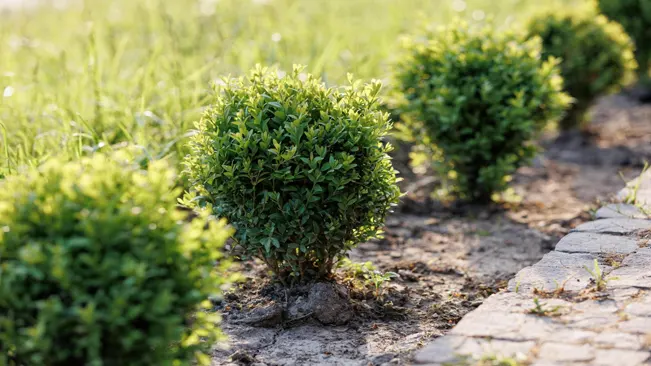
List on How To Plant Dwarf Boxwood Hedge
Selecting the Right Variety
Before planting, it’s essential to select the right variety of dwarf boxwood. Common types include Buxus sempervirens ‘Suffruticosa’ and Buxus microphylla. These varieties are known for their compact growth and resilience. Choose a variety that suits your climate and garden style.
Buxus sempervirens ‘Suffruticosa’

- Commonly known as English boxwood.
- This variety is particularly favored for its dense, lush foliage and relatively slow growth rate, which makes it ideal for formal hedges and topiaries.
- It has a rounded, compact form and can reach up to 2-3 feet in height.
- Prefers partially shaded to full sun areas and adapts well to various soil types, though well-drained soil is ideal.
Buxus microphylla

- Also known as Japanese boxwood.
- This variety is known for its slightly faster growth rate compared to ‘Suffruticosa’.
- It tends to have a more open and loose structure, making it a good choice for informal hedges.
- It can tolerate a range of sun exposures, from full sun to partial shade, and is quite versatile in different soil conditions.
- Generally, it’s more heat tolerant than English boxwood, making it suitable for warmer climates.
Site Preparation
Boxwoods prefer well-drained soil and a location that receives partial to full sun. Prior to planting, prepare the site by
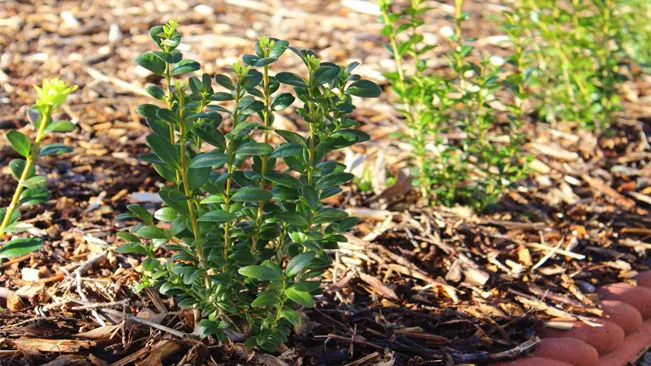
- Clearing the Area:
- Importance: It’s crucial to start with a clean slate. Weeds and debris can compete with young boxwoods for nutrients and water, and they can also harbor pests and diseases.
- How to Clear: Remove all weeds, grass, stones, and any other debris from the planting area. This can be done by hand or with the help of tools like a hoe or a garden rake.
- Testing Soil pH:
- Why pH Matters: Boxwoods prefer a slightly acidic to neutral pH range (between 6.5 and 7.5). The pH level of your soil can affect nutrient availability and overall plant health.
- Testing Process: You can purchase a soil pH testing kit from a garden center or online. Follow the instructions provided with the kit to collect a soil sample and measure the pH.
- Adjusting pH: If your soil is too acidic (below 6.5), you can raise the pH by adding lime. If it’s too alkaline (above 7.5), you can lower the pH with sulfur or aluminum sulfate. Follow the instructions on the product’s label for the correct application.
- Amending the Soil:
- Benefits of Soil Amendment: Adding organic matter like compost or well-rotted manure improves soil structure, drainage, and fertility.
- Choosing the Right Amendment: Compost is generally a safe choice as it is neutral in pH and rich in nutrients. Well-rotted manure can also be beneficial but ensure it is well-composted to avoid burning the plants.
- Application: Mix the organic matter into the top 6-12 inches of soil. This can be done using a shovel or a rototiller, depending on the size of your planting area.
- Considering Drainage:
- Why Drainage Matters: Boxwoods don’t like “wet feet” and can suffer from root rot in poorly drained soils.
- Improving Drainage: If you have heavy clay soil, consider raising the planting area by creating a raised bed or adding more organic matter to improve the soil structure. In extremely poor draining areas, consider installing a drainage system or choose a different planting site.
Planting the Hedge
Spacing
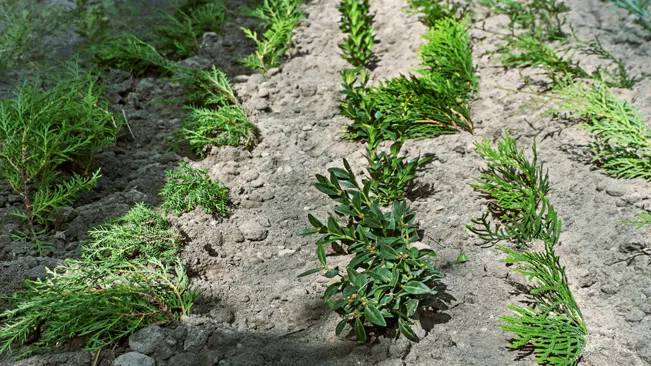
- Spacing is crucial for the health and appearance of your hedge. Dwarf boxwoods should be planted about 1 to 2 feet apart. This distance allows each plant enough room to grow without overcrowding, yet close enough to eventually form a continuous hedge. The exact spacing can depend on the specific variety of boxwood and the desired thickness of the hedge. Closer spacing will result in a denser hedge more quickly, but requires more plants.
Planting Technique
- Trench vs. Individual Holes: You can either dig a continuous trench or individual holes for each plant. A trench might be easier if you’re planting a long hedge, as it ensures a uniform level and depth for the entire line of plants. For smaller hedges or individual sections, separate holes may be more practical.
- Size of Planting Hole: The hole or trench should be about twice as wide as the root ball of your boxwood plants. This extra space allows roots to spread out easily, promoting better growth. The depth should be equal to the height of the root ball to prevent planting too deep, which can lead to root rot.
- Planting Process: Gently remove the boxwood from its container. If the roots are densely packed or circling, lightly tease them apart to encourage outward growth. Place the plant in the center of the hole or trench, ensuring it sits at the same level it was in the container, not deeper or higher. Backfill with the excavated soil, gently firming it around the roots to eliminate air pockets.
Watering

- Initial Watering: After planting, water each boxwood thoroughly. This helps settle the soil around the roots and removes further air pockets. The goal is to ensure that the root zone is completely moistened.
- Ongoing Watering: Boxwoods prefer consistently moist soil, especially in the first year after planting, which is critical for their establishment. However, it’s important to avoid overwatering, as boxwoods do not tolerate waterlogged soil well. A good rule of thumb is to water when the top inch of soil feels dry. The frequency will depend on your climate and soil type – sandy soils require more frequent watering than clay soils.
- Mulching: Applying a layer of organic mulch around the plants can help retain soil moisture and reduce watering frequency.
Ongoing Care
Mulching
Mulching is a critical practice in the care of boxwood hedges. Here’s why it’s beneficial and how to do it properly:
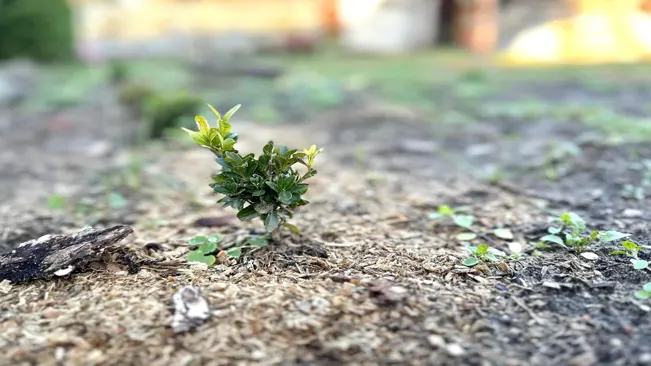
- Purpose: Mulch helps retain soil moisture, keeping the roots cool and moist, which is especially important during hot or dry spells. It also suppresses weed growth and adds organic matter to the soil as it decomposes.
- Application: Apply a 2 to 3-inch layer of organic mulch, such as shredded bark, compost, or leaf mold, around the base of each plant. Be careful not to pile the mulch against the stems or foliage, as this can encourage rot or pest infestations.
- Frequency: Refresh the mulch layer annually or as needed when it begins to break down.
Feeding
Fertilizing your boxwood hedge is vital for its growth and health:
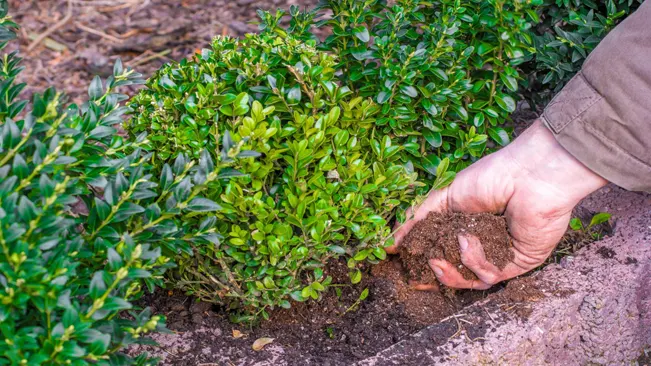
- Type of Fertilizer: A balanced, slow-release fertilizer is ideal for boxwoods. Look for a formula with an NPK (nitrogen, phosphorus, potassium) ratio like 10-10-10 or similar.
- Timing: Apply the fertilizer in early spring as the plants begin active growth. This helps them develop strong roots and lush foliage.
- Method: Follow the manufacturer’s instructions for the application rate. Typically, you’ll sprinkle the granular fertilizer around the base of each plant and then water thoroughly to help the nutrients seep into the soil.
Pruning
Pruning is crucial for maintaining the shape and health of your hedge:
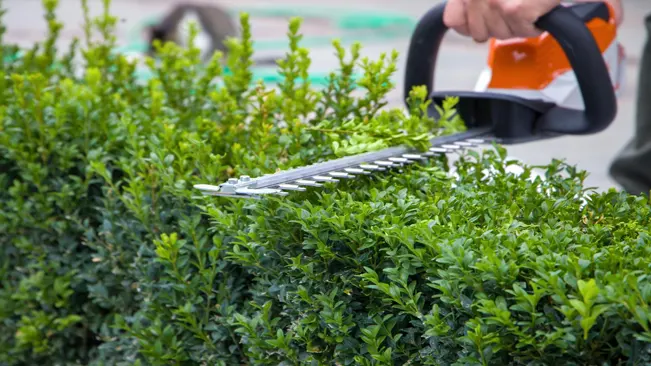
- Best Time: Late winter or early spring, before new growth starts, is the best time to do major pruning. This timing allows the plant to heal quickly and put energy into new, healthy growth.
- Technique: Use sharp, clean pruning shears or hedge clippers. Make cuts just above a leaf node or bud. For a formal hedge, you may use strings or stakes to guide you in creating straight lines.
- Light Trimming: During the growing season, light trimming can be done to maintain the desired shape or size. This is less stressful for the plant and helps encourage denser growth.
Pest and Disease Management
Being proactive about pests and diseases is key:
- Common Issues: Boxwood blight and leafminers are common. Blight causes dark leaf spots and stem cankers, while leafminers cause blister-like trails on leaves.
- Regular Inspection: Check your plants regularly for signs of trouble. Early detection is crucial for effective treatment.
- Treatment: If you detect pests or diseases, treat them promptly. For organic control, neem oil or insecticidal soaps can be effective against certain pests. For diseases like blight, fungicides may be necessary. Always follow the label instructions for any treatment.
- Preventative Measures: Ensure good air circulation around your plants to reduce disease risk. Avoid overhead watering, as wet foliage can promote fungal diseases.
Conclusion
Planting and caring for dwarf boxwood hedges involves a thoughtful combination of proper site preparation, correct planting technique, and ongoing maintenance. Ensuring well-drained soil, appropriate spacing, and consistent moisture through watering and mulching are fundamental to their success. Regular feeding, prudent pruning, and vigilant pest and disease management are essential for maintaining the health and aesthetics of the hedge. With these practices, dwarf boxwood hedges can become a long-lasting and elegant addition to any garden landscape.
FAQs (Frequently Asked Questions)
- What is the best time of year to plant dwarf boxwood hedges?
Planting in early spring or fall is ideal, as cooler temperatures and moist soil help the roots establish. - How far apart should I plant dwarf boxwood shrubs for a hedge?
Space them about 1 to 2 feet apart to ensure dense growth and a well-formed hedge. - Do dwarf boxwoods require full sun or can they grow in shade?
Dwarf boxwoods prefer partial to full sun but can tolerate light shade. However, too much shade may lead to sparse growth. - What type of soil is best for dwarf boxwood hedges?
They thrive in well-drained soil with a slightly acidic to neutral pH, between 6.5 and 7.5. - How often should I water my newly planted dwarf boxwood hedge?
Water regularly to keep the soil consistently moist, especially in the first growing season. Avoid overwatering or waterlogging. - When and how should I prune my dwarf boxwood hedge?
Prune in late winter or early spring before new growth starts, using sharp shears to shape. Light trimming can be done in the growing season to maintain the shape. - What type of fertilizer should I use and how often?
Use a balanced, slow-release fertilizer in early spring. A formula with an NPK ratio like 10-10-10 is suitable. - How do I mulch around my boxwood hedge and why is it important?
Apply a 2 to 3-inch layer of organic mulch, like shredded bark or compost, around the base of the plants. It helps retain moisture and suppress weeds. - What are common pests and diseases that affect dwarf boxwoods, and how do I manage them?
Watch for boxwood blight, leafminers, and mites. Use appropriate organic or chemical treatments as needed, following label instructions. - Can dwarf boxwoods be planted in containers, and if so, what care do they need?
Yes, they can grow in containers. Ensure adequate drainage, regular watering, and occasional pruning. Repot every few years to refresh the soil.

Kristine Moore
Forestry AuthorI'm Kristine Moore, a seasoned garden landscaping professional with over 30 years of experience. My extensive career has been dedicated to transforming outdoor spaces into stunning, sustainable landscapes. With a deep understanding of horticulture, design principles, and environmental stewardship, I have become a respected figure in the field, known for creating harmonious, visually appealing, and eco-friendly gardens. My commitment to excellence and continuous learning in landscaping trends and techniques has solidified my reputation as an expert in garden design and implementation.



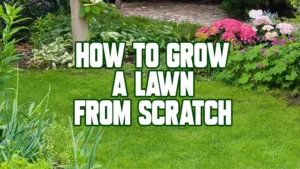








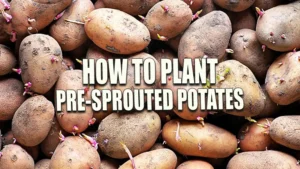
Leave your comment